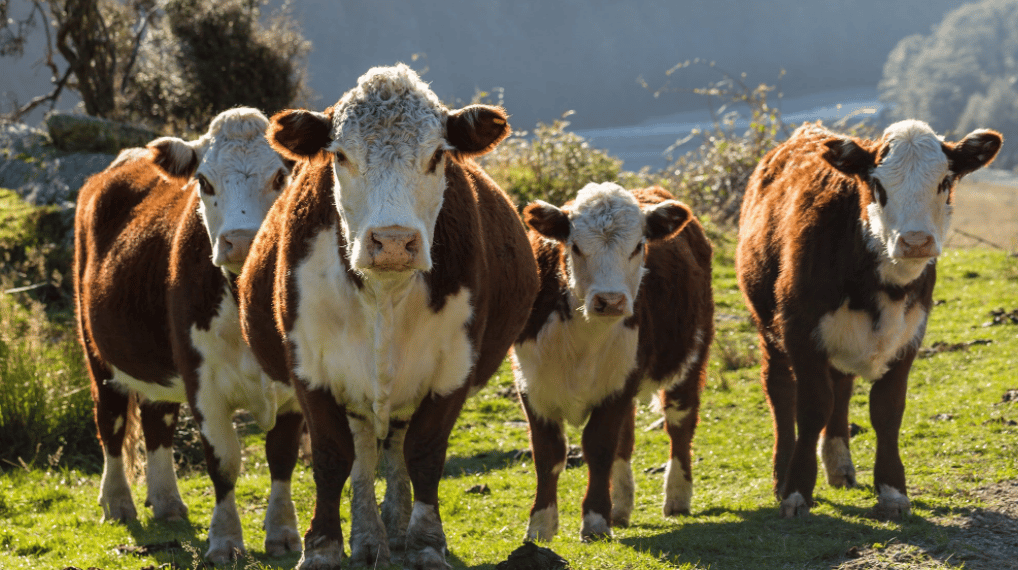What is Hereford Cattle?
Traditional and purebred Hereford cattle originated from Herefordshire in England, and this breed has existed since the 17th century.
There are interesting facts about Hereford cattle such as natural polledness, although some are horned, its red piebald coat and forehead curls, white-red face, being one of the most crossed cattle breeds, etc.
Hereford cattle breed was bred as an ox and used to work in the garden, but with the large size, adaptability to different weather conditions, friendliness, feed conversion to milk and meat quality, and other good traits of this breed, it was later raised to for meat and milk, especially meat.
Are there Cons of the Hereford Cattle Breed?
Hereford cattle were once in the number one spot in Australia, New Zealand, and North and South America for ages.
While there are many advantages of raising Hereford cattle for commercial meat and milk production, comparing Hereford’s strength and weaknesses to other crossed breeds is the main reason Hereford cows and bulls are not much popular today.
Also, purebred Hereford heifers are difficult to find and purchase, and there are now better breeds that perform better in terms of meat production.
Some of the characteristics of Hereford cattle are debatable because while some cattle possess these qualities, some others do not, so it’s a different experience for breeders.
Disadvantages of Hereford Cattle
The following are the few disadvantages of raising commercial Hereford cattle you should be aware of.
Hereford cattle can not bear extreme climatic conditions
It is a fact that Hereford cattle can adapt to different environments, but they don’t often do well in extreme climatic conditions.
An environment where there can be sudden changes in the climate, such an environment is not suitable for Hereford.
There are better breeds that have been developed to adapt to homesteads in tropical, hot climates, but not therefore cattle.
Hereford cattle can easily get sunburned
If you raise Hereford cattle in a hot climate, your herd is at risk of getting sunburned.
Hereford cattle have pale udders that are exposed to the environment and the risk of sun damage.
This can therefore attract germs and cause infection in their body.
Diseases in your herd can affect your productivity, and thus the cost of fighting infection and diseases can greatly affect your profitability.
Hereford cows are at risk of Vaginal prolapse
Vaginal prolapse usually occurs in the late pregnancy of cattle when the cattle are about to calve.
Hereford cattle have some structural weaknesses, and one of them is that the huge size of the uterus and weight put pressure on the pelvis which causes the vaginal to prolapse.
Mild prolapse does occur in huge-sized cattle during calving and it will go back after birth but when it’s severe, the attention of a veterinarian will be needed.
Hereford cattle have a good calving rate but when vaginal prolapse occurs, it can be a serious problem for the animal and the herder.
Poor Udder Structure
Hereford cattle produce high-quality milk, but some cattle do not produce enough milk while some produce a high volume of milk and later have udder problems.
The udder structure is poor, and pale, and can easily expose the animal to the risk of sunburn.
Hereford cattle may have eye problems
While it’s on a low scale, it’s important to take note if there’s a pink color pigment in the eyes of the cow before you purchase her calf.
Hereford cattle may develop eye cancer or other eye problems later in life.
Hereford may have skin Problems
Hereford cattle breed have a white coat and can be prone to skin pigmentation and cancer, or any other skin problems.
Hereford cattle may not mature as fast as you expected
Another disadvantage of Hereford cattle that is very debatable is growing and maturing.
Hereford can grow and mature fast, but in some cases, this cattle breed is slow in maturing, and have poor feet and legs.
Also, there are better breeds like Brown Swiss Bull that take lesser months to mature and start yielding profit to farmers.
The longer it takes your Hereford cattle to mature, the more you’d have to spend in raising them to maturity, and thus the less your profit may become.
It has an average Lifespan
Hereford cattle can live up to 20 years with proper feeding, housing, exercise, calving, and when other quality care are given.
However, an average Hereford cattle live for 14 to 17 years. While this is not a short lifespan per se, this is low when compared to other developed breeds that can live longer and healthy.
Problem with calving
Some cattle breeders also complain of calving issues with Hereford because of the big head, big head, shoulder, and hips problems.
However, you can still overcome most of the disadvantages of Hereford cattle with a good selection of stocks.








